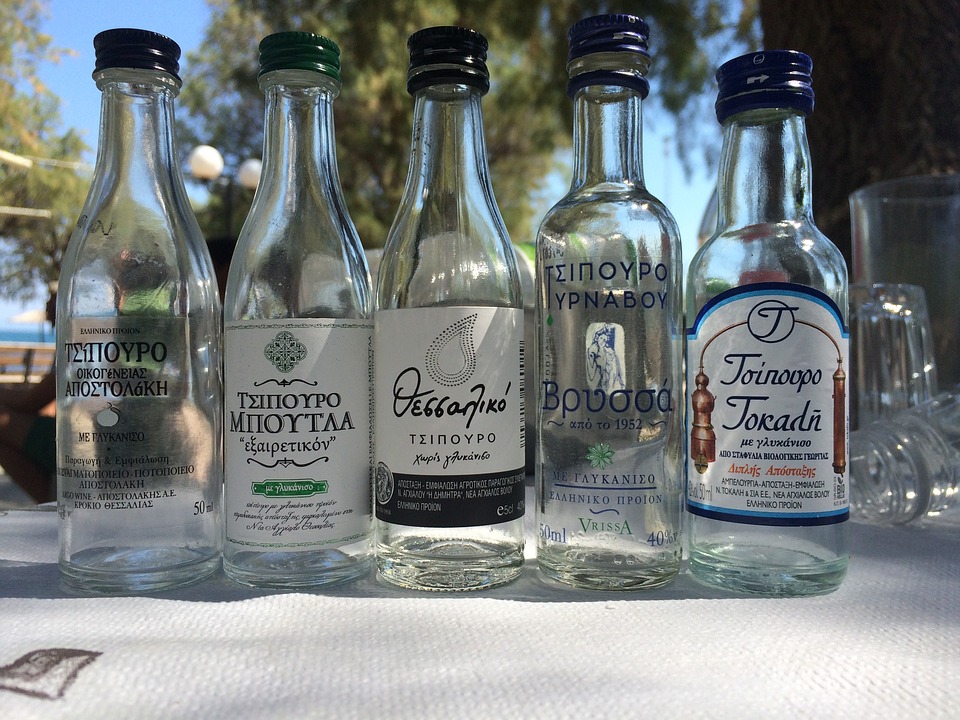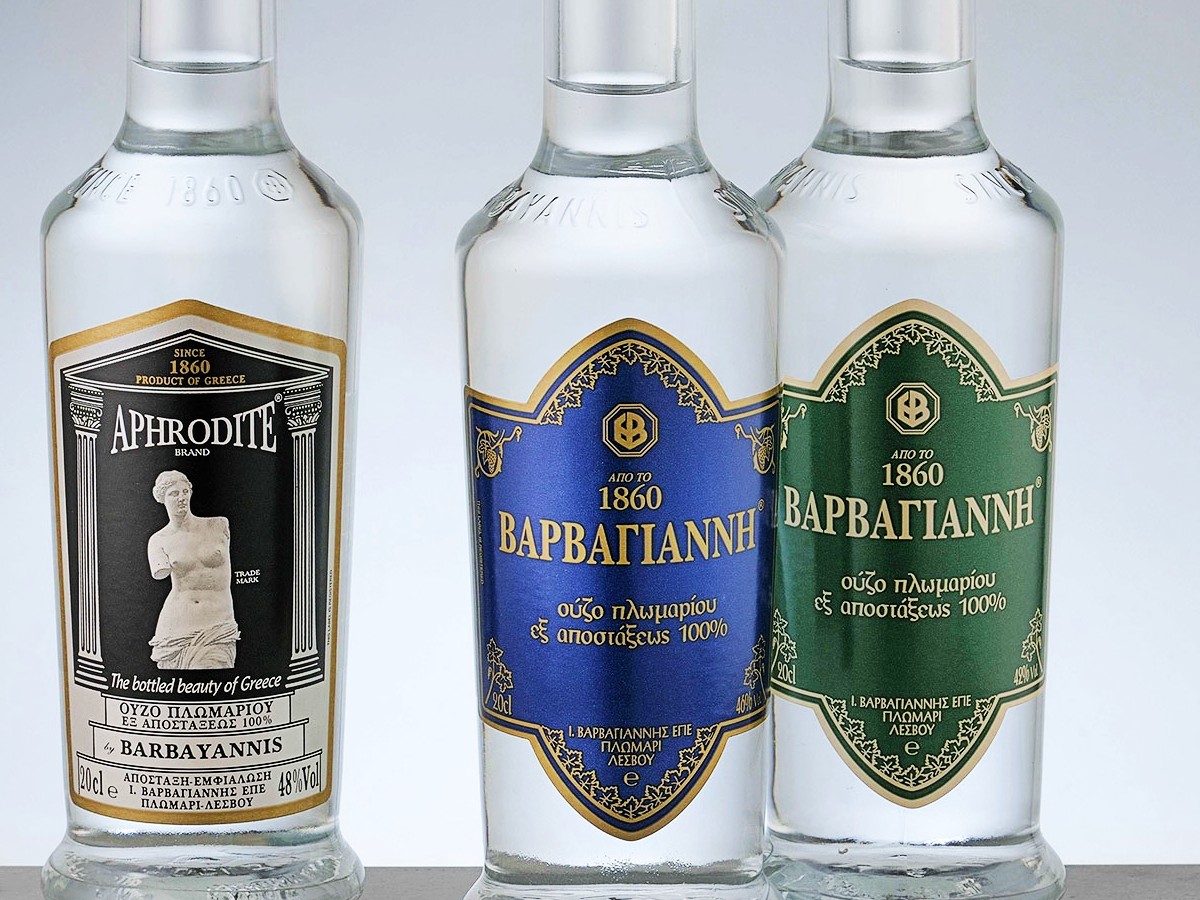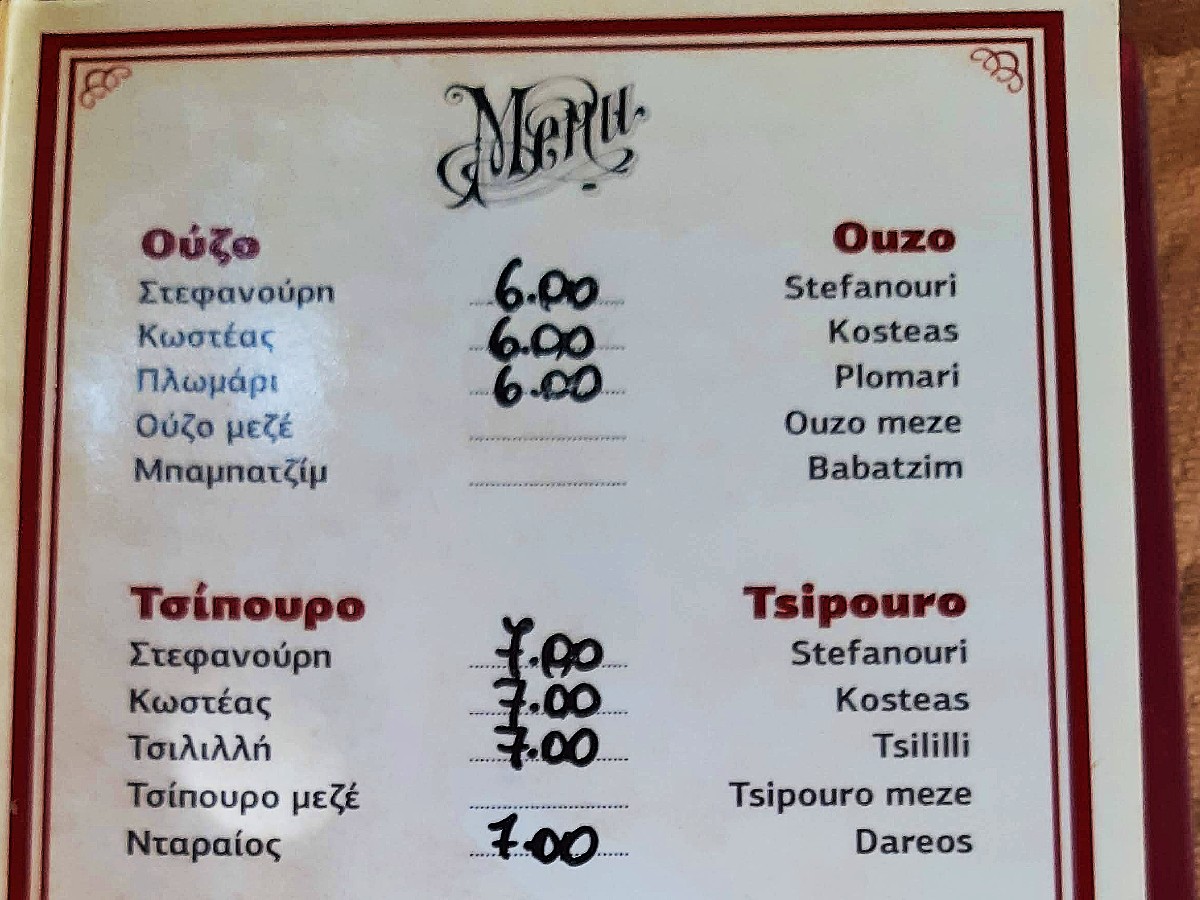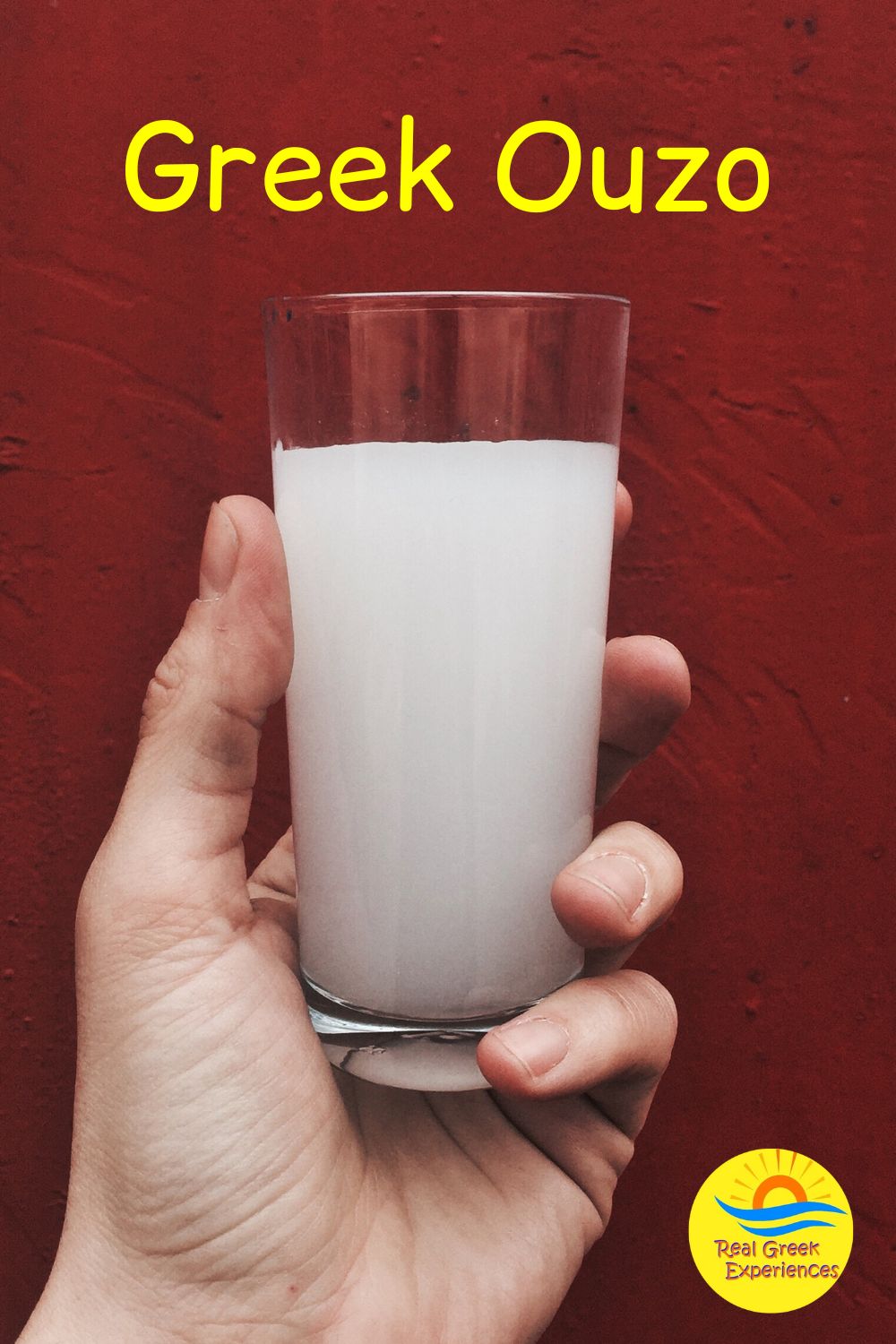Ouzo is a uniquely Greek alcoholic drink which tastes of anise. Here is some more information about Greece’s national drink!

Everything you need to know about Greek Ouzo
If you are planning a trip to Greece, you will probably read about a strong alcoholic drink called Ouzo. This anise flavored liquor is a popular Greek drink, which you will find in every Greek restaurant, supermarket or food tour in Greece.
Ouzo is a product made out of the distillation of alcohol and aromatic herbs. Apart from anise, herbs commonly used in Ouzo production are fennel, coriander, cinnammon, and many more.

Let’s find out more about Ouzo production in Greece, what to drink Ouzo with, and the best Ouzo in Greece!
History of Ouzo and the first Ouzo distillery
The process of distillation in order to make alcoholic drinks has been known since the ancient times. There is strong evidence that a drink similar to Ouzo was produced at the times of the Byzantine Empire.
During the Ottoman period, traditionally distilled alcoholic drinks were widespread throughout several regions around the Mediterranean. This includes present-day Greece, Turkey, and areas of the Middle East.
After the War for Greek Independence, in 1821, the production of these drinks continued in Greece. The most common distilled drinks, tsipouro and raki, were made after distilling the wine by-products.

In 1856, Nikolaos Katsaros, a man from a village called Tirnavos in Thessaly, decided to further distil a batch of tsipouro, and add some aromatic herbs to improve the taste. Hence, the first Ouzo was born! At first, people used the word “Ouzo” to indicate an anise-flavored distilled drink of exceptional quality, “good enough to be exported”.
That first Ouzo distillery still exists today, and is run by the great-great-grand son of the first Ouzo maker. Other regions of Greece where you can find Ouzo of superior quality include Plomari and Mitilini in Lesvos island, Kalamata, Chios, Volos, and elsewhere. Ouzo is a Protected Designation of Origin product, and can only be produced in Greece.
Ouzo is an exclusively Greek product
The phrase “Protected Designation of Origin” (PDO) is a type of geographical indication, widely used in the European Union and the United Kingdom.
The term PDO suggests that a product has been “produced, processed and developed in a specific geographical area, using the recognized know-how of local producers and ingredients from the region concerned”. You can read more about it here.

According to this definition, this means that similar anise-flavored liquors made outside of Greece cannot bear the label “Ouzo”.
Other examples of Greek PDO products include Kalamata olives, Santorini tomato, Chios mastiha, and our famous Feta cheese!
What is Ouzo made from
Unlike tsipouro, Ouzo is not a product of grape distillation. Instead, it is an industrial mixture of 100% pure ethyl alcohol of agricultural origin, water and aromatic substances. The main aromatic substance used is anise, the seed of the aniseed plant, whose active compound is anethole.
According to the EU regulation 1576/89 and Greek law, for a product to be called Ouzo:
- it must be a PDO product of Greece
- it must have been flavored by distillation or maceration with anise, and optionally other herbs and flavoring substances
- the percentage of the volume that has been flavored by distillation must be at least 20%
- the finished product must have an alcohol content of at least 37.5%.
Greek Ouzo brands
Today, there are over 300 (!) Ouzo producers in Greece. Out of those, 17 are on Lesvos island, which is often considered the homeland of Ouzo, accounting for about 50% of the total production.
Most Ouzo brands that you will find on the Greek market have an alcohol content of 40-42% vol. Depending on the brand, the taste of Ouzo varies, with some being more intense, sharper or sweeter than others.

The various herbs and other flavoring agents contribute to each brand’s special profile. Aromatic substances commonly used include fennel, mastic, star anise, licorice seeds, coriander, cardamom, nutmeg, cinnamon and cloves. The addition of colours and sweetening products such as sugar is also permitted.
Good quality Ouzo comes from 100% distillation, as written on the label. Some of the most popular Ouzo brands are Isidorou Arvaniti (Plomari), Barbayianni, Ouzo 12, Mini, Tsantali, Babatzim and Pitsiladi.
How is Ouzo produced
The mixture of alcohol, anise and aromatic substances is placed into special cauldrons where it is distilled. Each producer might follow a slightly different procedure, so the mixture might be heated, cooled off and distilled a number of times.
After the last phase of the distillation process, the product is stored in large stainless steel tanks to settle. This is where the ingredients of the recipe will blend together and become a homogeneous mixture. Good quality natural water is added to the blend, and the product is ready to be bottled.
Over the last decades, Greek Ouzo producers developed several premium products, produced after further distillation. This high quality Ouzo can be up to 46-48% alcohol, and makes for a special souvenir from Greece.
How to drink Ouzo
So, modern Ouzo distillation is quite a process. But how about drinking Ouzo? Well, this is also a ritual, and you should definitely try it when you go to have a meal at a Greek taverna!

Most Greeks drink Ouzo in a tall, thin glass, with added ice and iced water. As soon as water is added, Ouzo becomes cloudy / milky white, the anise and other aromas are released, and the alcohol content decreases. This turns Ouzo into a long drink, that you can enjoy for hours.
However, some people might prefer to drink Ouzo in a shot glass, without any ice or water. If you decide to try it straight, go very very slowly. Otherwise, you will definitely feel the Ouzo effect on the next day – and it’s not a pleasant one!
What do you drink Ouzo with
Ouzo itself is a strong spirit. However, when it’s served with icy cold water and accompanied by Greek appetizers (mezedes), most people find it rather refreshing. The best mezedes to drink Ouzo with include anything with a strong flavor, salty or spicy.
A few examples are seafood, grilled octopus, fried fish, smoked mackerel, herrings and taramosalata. But if you aren’t keen on seafood, you can pair it with spicy cheese salad (tirokafteri), strong cheeses, spicy peppers, sausage and stuffed vine leaves or even horta.
For more ideas on what to drink Ouzo with, have a look at this guide with 50 popular Greek dishes.
Most importantly, you need to drink Ouzo with your friends and family, over a long lunch or dinner. The more people, the merrier!

Can you mix Ouzo with other drinks?
Μixing Ouzo with other drinks is a relatively new concept. These days you can find certain cocktails and other blended drinks with Ouzo.
The most popular beverages to mix with Ouzo include orange juice, lemon juice (Ouzo lemonade), sour cherry and Coke. Recently, bar tenders have blended Ouzo with other ingredients, such as coffee, gin, tomato juice, Campari, mastiha, various other sweet liqueurs, and, believe it or not, even retsina wine!

Other anise drinks
So, is Ouzo the only Greek alcoholic drink that is flavored with anise? Actually, no. You can also get tsipouro with anise – though most Greeks seem to prefer the one without.
The aniseed plant is prevalent around the Mediterranean Sea. As a result, there are many other drinks with similar taste produced in this region, such as the following:
- Turkish Raki
- Middle Eastern Arak
- French Pastis
- Italian Sambuca
- Swiss Absinthe
- Bulgarian Mastika Peshtera
And what if you don’t like the flavor of anise? No worries – Greece has you covered! Here is everything you need to know about other Drinks in Greece.

FAQ about Greek Ouzo
Here are a few FAQs about Ouzo:
What is Ouzo?
Ouzo is a strong alcoholic drink made in Greece. It is made out of pure ethyl alcohol flavored with anise and possibly other spices. Contrary to popular belief, Ouzo is not made out of grapes!
What does Ouzo taste like?
Ouzo predominantly tastes of anise, which comes from the aniseed plant. Other aromatic substances commonly used include fennel, star anise, mastic, licorice seeds, cardamom, coriander, cinnamon and cloves.
How do you drink Ouzo?
Ouzo is usually served in a tall glass, with ice cubes and cold water. Greeks drink Ouzo along with food such as seafood, spicy sausages, strong-flavoured cheeses, and similar appetizers. You can also choose to drink it as an aperitif.
Does Ouzo contain sugar?
Some Ouzo brands contain sugar or other sweetening agent. However, you can also find Ouzo without added sweeteners.
How do Greeks say Cheers?
The Greek way to say ‘Cheers’ is ‘Yamas’. This is short for the phrase ‘Stin iyia mas’, which means ‘to our health’.
More guides about Greece
And now that you know everything about Ouzo, here are a few more guides that you will enjoy:
- Greek customs and habits
- Travel tips for Greece
- Shopping in Athens
- Movies about Greece
- Useful Greek words and phrases
- How to swear like a Greek
 Hi! I’m Vanessa from Athens. Whether you are planning to try Ouzo when you come to Greece or not, I hope you enjoyed this article. If you do, don’t forget to accompany your glass of Ouzo with some Greek food and great company. Yiamas!
Hi! I’m Vanessa from Athens. Whether you are planning to try Ouzo when you come to Greece or not, I hope you enjoyed this article. If you do, don’t forget to accompany your glass of Ouzo with some Greek food and great company. Yiamas!


Vanessa, typically how much water should you add to your ouzo before you sip away? Efcharisto, Jul
Everyone adds as much as they want! Some people just pour it on ice, some people add equal parts of ouzo and water. You can experiment with the flavour you like best – just don’t make the mistake to sip it without food. I’ve done that a few times in the distant past, definitely don’t recommend, lol 🙂